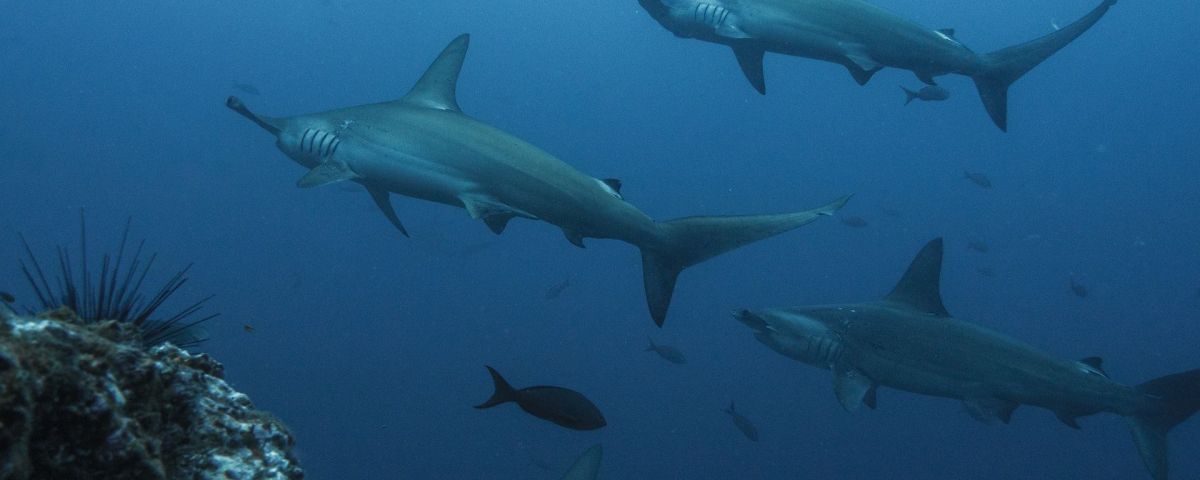Shortlisted for the 2023 Southwood Prize
Lucien Besnard reflects on how he and colleagues used mercury isotopes, within the framework of isotopic clocks, to provide a more precise assessment of hammerhead shark movement. As a result, this method may be used as a complementary tool for stock management through predicting the timing of animal migration – a key aspect in the conservation of marine taxa.
Advocating for shark conservation in the Mexican Pacific
Since childhood, the sight of a shark maneuvering gracefully through the water has captivated me, fueling my lifelong fascination for them. Sharks are more than mere icons lurking beneath the surface. They are among the architects of marine ecosystems, finely tuned by evolution to thrive in diverse habitats across the globe. Their ecological success story, spanning millions of years, showcases their remarkable adaptability and resilience. Yet, imperiled by human activities that threaten their very existence, this success now stands at risk, with overfishing emerging as the most significant threat.
Mexico, one of the largest producers of shark products globally, is particularly affected by this crisis. Along the Pacific coast, artisanal shark fisheries operate extensively, accounting for the large majority of elasmobranch products in Mexican markets. These fisheries, often lacking in sustainability practices, target a wide range of species and sizes, including juveniles before they reach reproductive maturity. Such lack of selectivity, coupled with a dearth of data on shark landings and the limited understanding of their local ecology hamper effective conservation efforts.
Despite national-scale measures, like the annual closure of shark fisheries from May to July, ensuring the long-term sustainability of shark populations in the Mexican Pacific requires more comprehensive management strategies. In that context, delving deep into the ecology of targeted species was the driving force behind my PhD journey.
Shark movement and overfishing
To mitigate the threat of overfishing, there is a need to comprehend the overlap between shark movements and fishing activities. In recent years, considerable efforts have been made to study shark migrations using biotelemetry technology, which mostly involved tagging individuals and tracking their movements via satellite technologies. In the Mexican Pacific, the urgency of the situation, combined with the limitations of traditional biotelemetry studies—such as temporal constraints between tag deployment and data retrieval, cost and tag burden, particularly for the monitoring of small individuals or early life stages—highlighted the necessity for alternative methodologies.
Tracking smooth Hammerhead migration with isotopic clocks

Hammerhead sharks are particularly susceptible to fishing pressure due to their unique ecological, functional, morphological, and behavioral characteristics. In the Mexican Pacific, historical records highlighted the disappearance of some hammerhead shark species due to fishing pressure, underscoring the urgent need for conservation efforts. While the smooth hammerhead shark is still heavily fished in the region, it remains the least studied of the large hammerhead species and movement data are currently unavailable in the northeastern Pacific. Our research aimed to fill this gap, using stable isotopes to identify the core habitats utilized throughout ontogeny.
Juvenile smooth hammerhead sharks undergo an ontogenetic habitat shift, with pups and young juveniles feeding in shallow coastal areas and close-to-maturity individuals foraging at depth in oceanic waters. Our study represented a pioneering effort in utilizing mercury isotopes within the framework of isotopic clocks to provide novel insights into the timing of such habitat shift. Benefitting from the long-standing collaboration and strong bonds forged between local researchers, students, and fishermen, we sampled smooth hammerhead sharks in artisanal fishing camps all across the Pacific coast of Baja California Sur.

Our findings surprisingly suggested a prolonged coastal residency period of approximately two years for smooth hammerhead sharks in the Mexican Pacific. This result carries significant implications, as it highlighted the long-term vulnerability of the species to the local high fishing pressure excessed in coastal habitats. It also emphasized the importance of implementing management measures beyond the annual suspension of shark fisheries, such as size limits and spatial closures, to protect juvenile smooth hammerhead sharks at least until they reach reproductive age, thereby ensuring the species long-term survival.

About the author
Throughout the course of my PhD, my perspective on shark fishing evolved as I engaged in collaborative work with fishermen. I advocate for recognizing the socio-economic significance of artisanal fisheries in the transition towards sustainable practices, emphasizing the importance of gradual changes rather than an abrupt halt to fishing activities.
In the future, I hope the ecological data gathered through my studies will help bridging science with practical conservation efforts. This study on mercury isotopic clocks represents a first step in that direction, with the possibility for researchers or diverse stakeholders to apply such approach using tissues sampled from non-lethal and relatively non-invasive methods.

I am now furthering my scientific journey as a postdoctoral researcher, still exploring the applications of mercury isotopes to unravel the ecological features of sharks but also expanding my scopes to the ecophysiological consequences of anthropogenic toxic mercury contamination on marine biota and humans.
Read the full article “Mercury isotope clocks predict coastal residency and migration timing of hammerhead sharks“ in Journal of Applied Ecology.
Find the other early career researchers and their articles that have been shortlisted for the 2023 Southwood Prize here!


